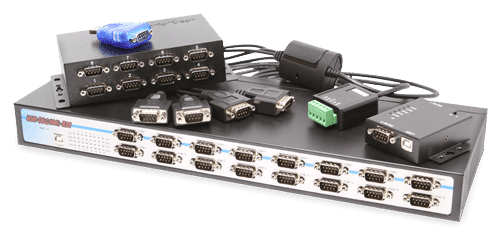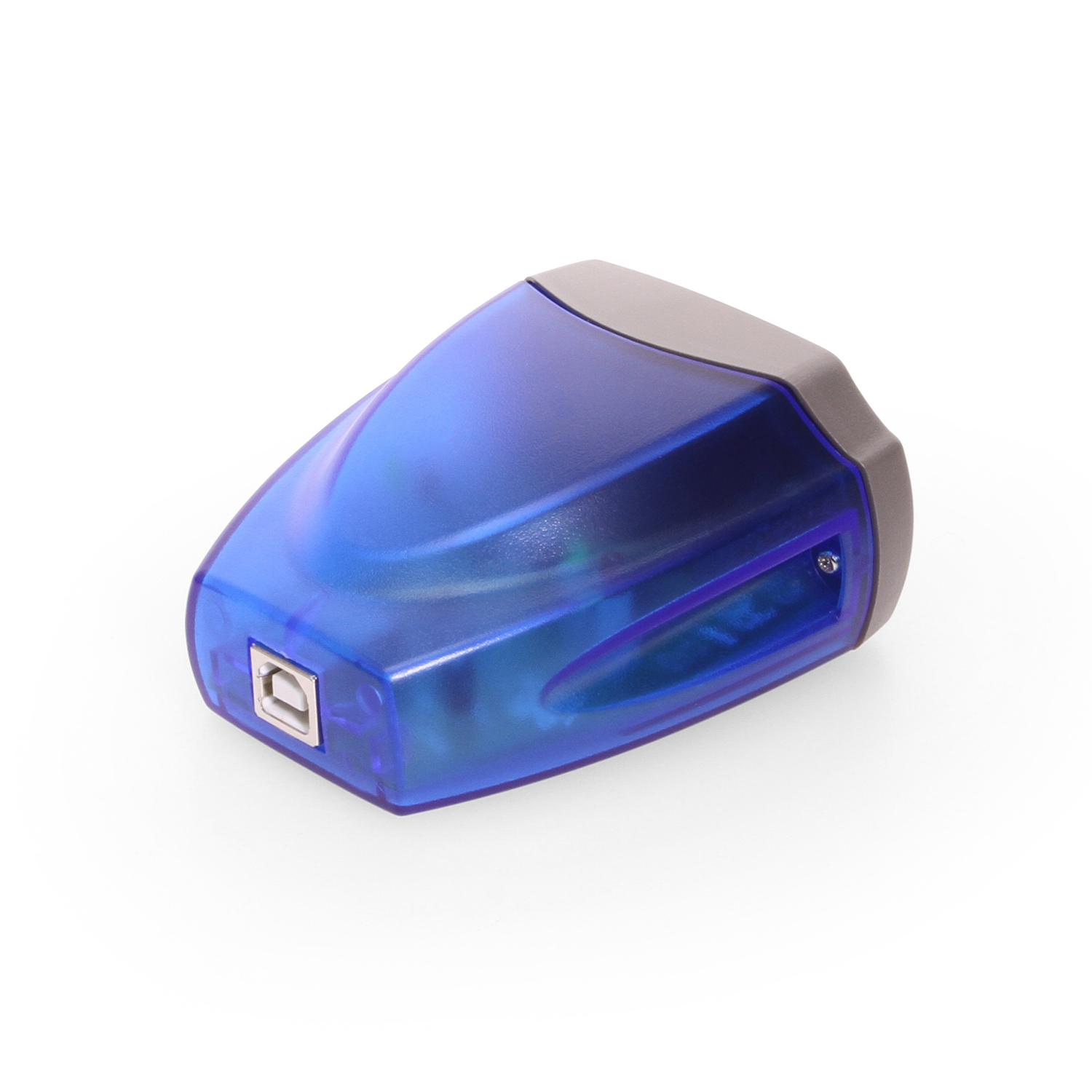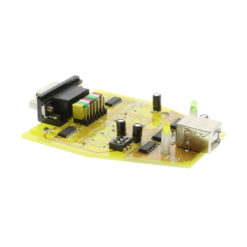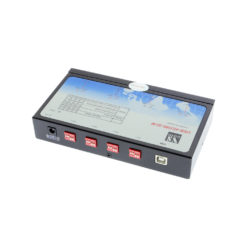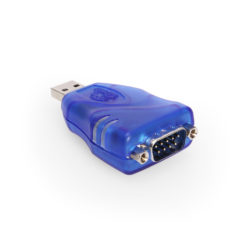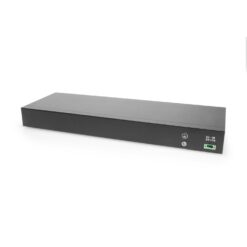Bulk Pricing
Single Port USB 2.0 to RS-422 / RS-485 DB-9 Serial Adapter
RS-422 | RS-485 | 128 Bytes Receive | 256 Bytes Transmit | FTDI
- Expand Your Serial Capabilities: The Mini Serial Adapter can be utilized through an existing USB Port to work with your legacy serial connections. It’s great for newer technologies with no serial port connections.
- Safe Connections: Designed with a unique system load reduction feature, the USB to Serial Adapter also offers 15kV surge protection for connected devices.
- Upstream: 1 USB port, Type B Female Connector
- Downstream: 1 Male DB9, w/ nuts
- RS-422 Signals: TxD-, TxD+, RxD+, RxD-, GND, RTS-, RTS+, CTS+, CTS-
- RS-485 Signals: TxD-, TxD+, RxD+, RxD-, GND
- Transmit Buffer: 256 Bytes
- Receive Buffer: 128 Bytes
Quick Links:
Description

Introduction
The Single Port USB 2.0 to RS-422 / RS-485 DB-9 Serial Adapter enables seamless communication between industrial RS-422 and RS-485 serial devices and a computer via a USB 2.0 port. This adapter is designed for environments that require reliable serial communication and efficient port expansion, making it an essential tool for system integrators, industrial automation professionals, and engineers needing high-speed data transfer in resource-constrained systems. With built-in direction control on RS-485 and Windows-native recognition as a standard COM port, it simplifies connectivity and management.
The Single USB to RS422 Serial Port Adapter with the 128 byte FIFO allows high-speed communication, even in heavy loaded systems or systems without native COM port access, unique features reduce the system load. The serial port adapter also allows unusual speed settings like 500.000bps.
RS-422 & RS-485 Mode Block Configuration SW (DIP Switch) for Mode Setting
| Operation Mode | S1 | S2 | S3 | |
| RS-422 | 4 wire with Handshaking | ON | ON | ON |
| RS-485 | Full Duplex (4 wire) | OFF | ON | ON |
| Half Duplex (2 wire) – with Echo |
OFF | OFF | ON | |
| Half Duplex (2 wire) – without Echo |
OFF | OFF | OFF |
Key Features and Benefits
- RS-422/RS-485 Support: Provides one RS-422/485 port with DB-9 male connection for flexible, robust serial communication.
- Automatic Data Flow Control: RS-485 communication automatically handles data direction, reducing the need for software management.
- High-Speed Data Transfer: Supports baud rates from 300bps to 921.6Kbps, with an additional unique speed setting of 500,000bps.
- FIFO Buffering: Features a 128-byte FIFO buffer, ensuring smooth high-speed communication even in heavily loaded systems.
- Visual Indicators: Built-in LEDs for transmit (TxD) and receive (RxD) provide clear, real-time communication status feedback.
- Cross-Platform Compatibility: Compatible with Windows 7, 8, 8.1, 10, 11, Linux, and Mac OS X, ensuring easy integration across systems.

Package Contents
- RS422/485 Single port adapter
- Manual
- Driver CD
- USB-COMi
- 3ft USB A to B Cable
Use Cases
Use Cases:
Industrial Automation
- Machine Monitoring: Connect serial-based sensors and controllers for real-time monitoring.
- Factory Communication: Facilitate seamless data exchange between control systems and machinery.
Data Acquisition
- Environmental Monitoring: Capture and log data from RS-422/485-enabled monitoring devices.
- Lab Equipment Integration: Interface with lab devices using RS-422 or RS-485 protocols.
Network Communication
- Remote Device Management: Enable communication between networked RS-485 devices and central management systems.
- Building Automation: Connect HVAC systems, security controls, and other building management infrastructure.
Quick Specs
Quick Specs:
Hardware Specifications
- Ports: One RS422/485 port
- Connectors: one DB9 male
- RS422/485 signals RS422 TxD+/-, RxD+/-,
- RTS+/-, CTS+/-, GND
- RS485 Data+/-, GND
- Baud Rate: from 300bps up to 921.6Kbps supported
- Transmit(TxD) and Receive(RxD) LEDS on unit for visual reference
- Universal Serial Bus(USB) port offers easy plug and Play Operation
Data Signals Supported:
- RS-422 data signals: TxD-, TxD+, RxD+, RxD-, GND, RTS-, RTS+, CTS+, CTS-
- RS-485 4-wire data signals: TxD-, TxD+, RxD+, RxD-
- RS-485 2-wire data signals: Data-, Data+
OS Support:
- Windows 7, Windows 8, 8.1, Windows 10, and Windows 11
- Linux and Mac OS 10.X
Ordering Information
- Product Name USB-COM-I
- Packing list USB-COM-I Adapter
- USB cable 0,9m
- CD, English Documentation
- Bus-powered. No external power supply needed.
Pin-Out
DB9 RS-422 Pin-Outs


DB9 RS-485 Half-Duplex Pin-Outs

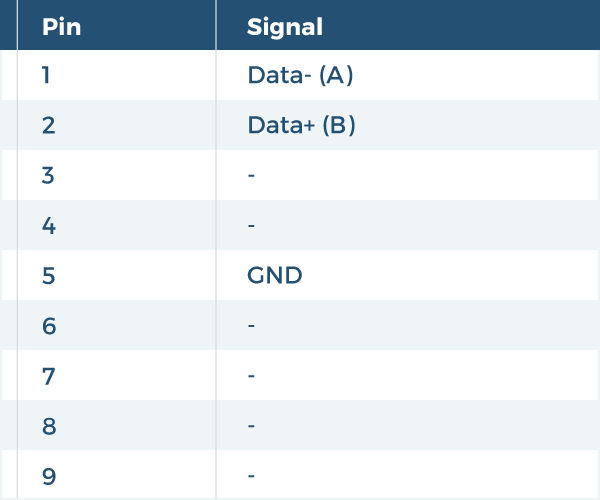
DB9 RS-485 Full-Duplex Pin-Outs

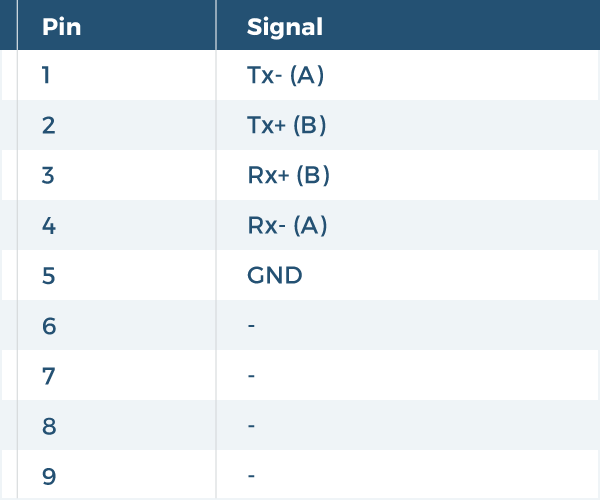
Specifications
Product Specifications
| Power |
| ||||||||||||||||||
|---|---|---|---|---|---|---|---|---|---|---|---|---|---|---|---|---|---|---|---|
| Compliance |
| ||||||||||||||||||
| Physical Characteristics |
| ||||||||||||||||||
| Serial Attributes |
| ||||||||||||||||||
| Software |
| ||||||||||||||||||
| Environmental |
| ||||||||||||||||||
| Product Information |
| ||||||||||||||||||
| Hardware |
| ||||||||||||||||||
| Performance & Safety |
| ||||||||||||||||||
| Other Data |
|
Downloads
| |
Windows FTDI Driver Compatible with Windows XP, Vista, 7, & 8 |
Accessories & Replacement Parts
Accessories & Replacement Parts
The RS422/485 single port serial adapter has certain accessories that work with it. These accessories are what you can order if needed.
Model# 9DBMF5FT
$3.98In stock
Support
Product Documentation & Drivers
Product Documentation
FTDI Drivers
Need drawings, CAD files, or other compliance documentation? Click HERE
Serial F.A.Q.
Product F.A.Q.
View frequently asked product questions below. For all serial troubleshooting, visit this page.
Still need help? Reach out!
-
How do I clean and reinstall my FTDI drivers?
View Answer
-
- Download the CDM Uninstaller HERE.
- Extract the zip file, or open the “CDMuninstallerGUI.exe” utility.
- Leave the ‘Vendor ID’ set to 0403 and ‘Product ID’ set to 6001.
- Click Add.
- Click Remove Devices.
- Download the corresponding driver for your operating system and follow on-screen prompts. Windows Driver | MacOS Driver
-
-
How can I change my device’s COM port?
View Answer
-
- Click on Start and navigate to the Control Panel
- Locate and click on Device Manager
- Under “Ports (COM & LPT)” you will find your serial device titled “USB Serial Port” along with its current COM Port.
- Right click on “USB Serial Port” and click on Properties.
- Navigate to the “Port Settings” tab and click on “Advanced…”
- Once there, the “COM Port Number:” can be changed with a dropdown menu to select the port number.
- Click your desired port number (i.e. COM2) and click “OK”.
- Click “OK” once more.
- Your serial device is now assigned to your chosen COM Port.
-
-
How do I check to ensure the COM port is listed properly in Windows?
View AnswerTo ensure your serial device is installed properly, complete the following:
- Press Windows Key + R to open the Device Manager. Once Run comes up, type “devmgmt.msc” into the text field and press Enter.
- Expand the section labeled, Ports (COM & LPT).
- You should now see a COM number in brackets to the right of each port. If the device is installed properly, no exclamation points or question marks should be present next to the device.
-
I have everything hooked up, but nothing is functioning correctly.
View AnswerTo rule out potential issues, quickly test your individual components to ensure that they are working correctly individually, and are not the source of the problem:
- Serial cables
- Serial ports
- Serial devices
Test your components by:
- Hook up the serial cable(s), serial port(s), and serial device(s) in a different setup to see if the issue stems from a particular component, or the setup as a whole.
- Replace the serial cable, port, or device within your setup to further troubleshoot the issue’s origin.
When testing cables:
- Test each cable individually.
- Use short cables when you are testing.
When testing serial ports and devices:
- Press the Windows key + R, in Run, type devmgmt.msc, and press Enter to open the Device Manager. You can then check to see if your device is listed under Ports (COM & LPT).
- Ensure that the COM port number is the correct number for the serial device and that the software being used to connect the computer to the serial device uses the correct COM port number.
- If the device is listed with an error, follow the instructions on the website to reinstall the drivers.
-
Serial communication is not functioning correctly, how can I tell if the problem caused by the adapter or my serial software application?
View AnswerOlder serial communication applications make use of legacy hardware addresses, often incompatible with PCI, PCIe, and USB to Serial products. Contact the software provider to troubleshoot.
-
I am receiving an error when I try to install the drivers in Windows 8 64 bit.
View AnswerDriver Signature Enforcement in Windows 8 may need to be disabled in order to use various drivers. After disabling this feature, the driver will be allowed to install.
Note: You are required to restart your computer after disabling the Driver Signature Enforcement. Save all open work on your computer.
Disable driver signature enforcement:
- Press the Windows key + C.
- Click Settings > Change PC Settings.
- In the left pane, click General.
- In the right pane, under Advanced startup, click Restart now.
When your system restarts:
- Click Troubleshoot > Advanced options > Startup Settings > Restart.
- Press 7.
When your computer restarts, Driver Signature Enforcement will be disabled and you can install the drivers.
-
I am receiving an error when I try to install the drivers in Windows 10 64 bit.
View AnswerDriver Signature Enforcement in Windows 10 may need to be disabled in order to use various drivers. After disabling this feature, the driver will be allowed to install.
Note: You are required to restart your computer after disabling the Driver Signature Enforcement. Save all open work on your computer.
Disable Driver Signature Enforcement:
- Click the Windows icon in the taskbar.
- Click Power.
- Press and hold the Shift key and click Restart.
After your computer restarts:
- Click Troubleshoot > Advanced Options > Startup Settings > Restart.
- Press 7.
When your computer restarts, Driver Signature Enforcement will be disabled and you can install the drivers.
-
Why did the software not install properly in macOS High Sierra (10.13) or later?
View AnswerHigh Sierra 10.13 and later versions of macOS enforce strict security policy revisions. In order for the device to operate, software packages like those used in this installation must be allowed in macOS Security and Privacy settings once the software is installed.
Once the driver/software is installed, follow these steps to allow the software:
- Open System Preferences.
- Open Security & Privacy.
- Click the Allow button near the bottom of the General tab.











